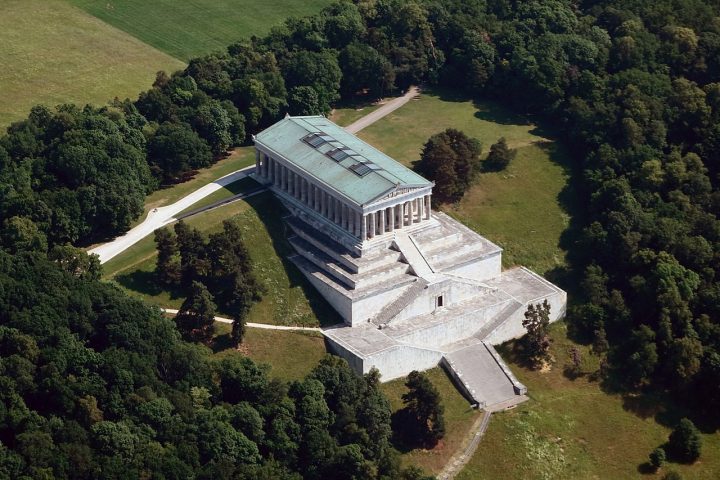
Leo von Klenze (full name Franz Karl Leopold von Klenze) (ᛉ February 29, 1784 in Buchladen – ᛦ January 26, 1864 in Munich) was a German Neoclassicist architect, painter and writer. Court architect of Bavarian King Ludwig I with whom he had a somewhat turbulent relationship (as we will see later on). Leo von Klenze was one of the most prominent representatives of the Greek revival style in Germany.
We can safely assume that Klenze’s three most recognizable architectural works are probably The Glyptothek, The Bayerische Ruhmeshalle (with its iconic Statue of Bavaria by Ludwig Schwanthaler) and the monumental Walhalla. Some years ago, during my very short trip to Munich (back in 2009) I was lucky enough to be able to visit most of these buildings, except the Walhalla, a thing which really bothers me even to this day. On the other hand I was able to visit the Odeonplatz, in the heart of that city, which also displays a pretty well-known architectural work by Klenze (as Third Reich connoisseurs will likely recognize). This article -however- will be mostly focused on Klenze the accomplished painter, as the gallery at the end of the page will show.
Might the reader be thinking on paying a visit to the city of Munich (and its surrounding area) soon, please, keep in mind Munich is not only a city of museums. The place has a lot more things to offer to the culturally-inclined visitor… never mind if certain events over there have been unfortunately terminated this year due to the Covid Plandemic.
The text for the biography next is mostly taken from Ludwig I of Bavaria website. For in-depth information about Leo Von Klenze’s life and works I would highly recommend downloading this 2018 PDF courtesy of muenchen.de
As always comments will be appreciated.
Biography
“Never has there been, and never will there be, more than one art of building, namely, that which was brought to perfection during the epoch of the prosperity and civilization of Greece.” – Leo von Klenze
Leo von Klenze (1784-1864) is most famous for his work as King Ludwig‘s court architect. He was one of the most celebrated architects of his time, rivaled only by his friend, Karl Friedrich Schinkel in Berlin. Klenze was also an accomplished painter and writer, as well as an avid collector of important contemporary German art. Klenze sold some 58 landscapes and genre paintings to Ludwig in 1841, and these became part of the initial collection of the Neue Pinakothek museum when it was established in 1853.
In addition, he served as an art agent for Ludwig, as well as a diplomat. Klenze was born in Hildesheim in Lower Saxony. He was the son of a prosperous magistrate who tried to dissuade him from becoming an architect because he was doubtful that the profession could provide an adequate income. His father allowed him nonetheless to attend the Bauakademie (Building Academy) in Berlin.
Klenze’s success at the academy prompted his father to allow him to visit Paris and London, and then make a Grand Tour to Italy and Greece, where he became enamoured of classical architecture. He is said to have made 26 trips to Italy during his lifetime. After his first stay in Italy, Klenze was appointed Court Architect in Kassel to Napoleon’s brother, Jerome Bonaparte, the King of Westphalia. Klenze built his first theater there. Following Jerome’s downfall in 1813, Klenze moved to Paris with his wife, Maria Felicitas Blangini (1790-1844) a beauty he met at the court of Ludwig I.
Crown Prince Ludwig met Klenze in 1815 and persuaded him to move to Munich to take the lead in a major urban renewal project which predated Baron Haussmann in Paris. Their relationship through the years was an adversarial, often contentious, one. Klenze was the chief architect, but Ludwig was the head contractor. Later, even though he had become a multi-millionaire and one of the most successful and influential architects of the 19th century, Klenze would complain:
“Oh, miserable fate, its existence based on a prince’s shifting patronage. I made this mistake at the highest level, but then what could I do after taking the first step?”
“Oh! It’s true, I have my Lord to thank for almost all that I have gained materially and what I am… but believe me, I have experienced bitter, bitter moments with him.”
His first project for Ludwig was the Glyptothek, begun in 1816 and completed in 1830. During the progress of the Glyptothek, he worked on other buildings, including the Reitbahn (or Riding-house) in 1822, the KriegsMinisterium (or War Office) in 1824, the Odeon in 1826, the Allerheiligen Kapelle in 1826, the Alte Pinakothek in 1826, the Königsbau and Festbau in 1827, the Prince Maximilian’s Palace in 1828, and the Ionic Monopteros (or Polychromic Temple) in the English Garden in 1833.
Klenze, directed by Ludwig, created the plan for the Ludwigstrasse, the grand boulevard running 1.2 kilometers from the Odeonsplatz in front of the Residenz to the Siegestor (Triumphal Arch). In 1830, Klenze began work on the Walhalla, the Hall of Fame of German Heroes.
Von Klenze died in 1864 and was buried in the Alter Südfriedhof in Munich.
A three-volume collection of the correspondence between Ludwig and Klenze was published under the direction of Dr. Hubert Glaser, the first in 1998 and the last in 2011. The work totals 6,000 pages with 1,600 letters.
Sources: Ludwig I of Bavaria website, wikipedia, City of Munich website, SciHi Blog, and Le Prince Lointain.
 RSS Feed
RSS Feed













 September 25th, 2020
September 25th, 2020  Awake Goy
Awake Goy 



 Posted in
Posted in  Tags:
Tags: 
















